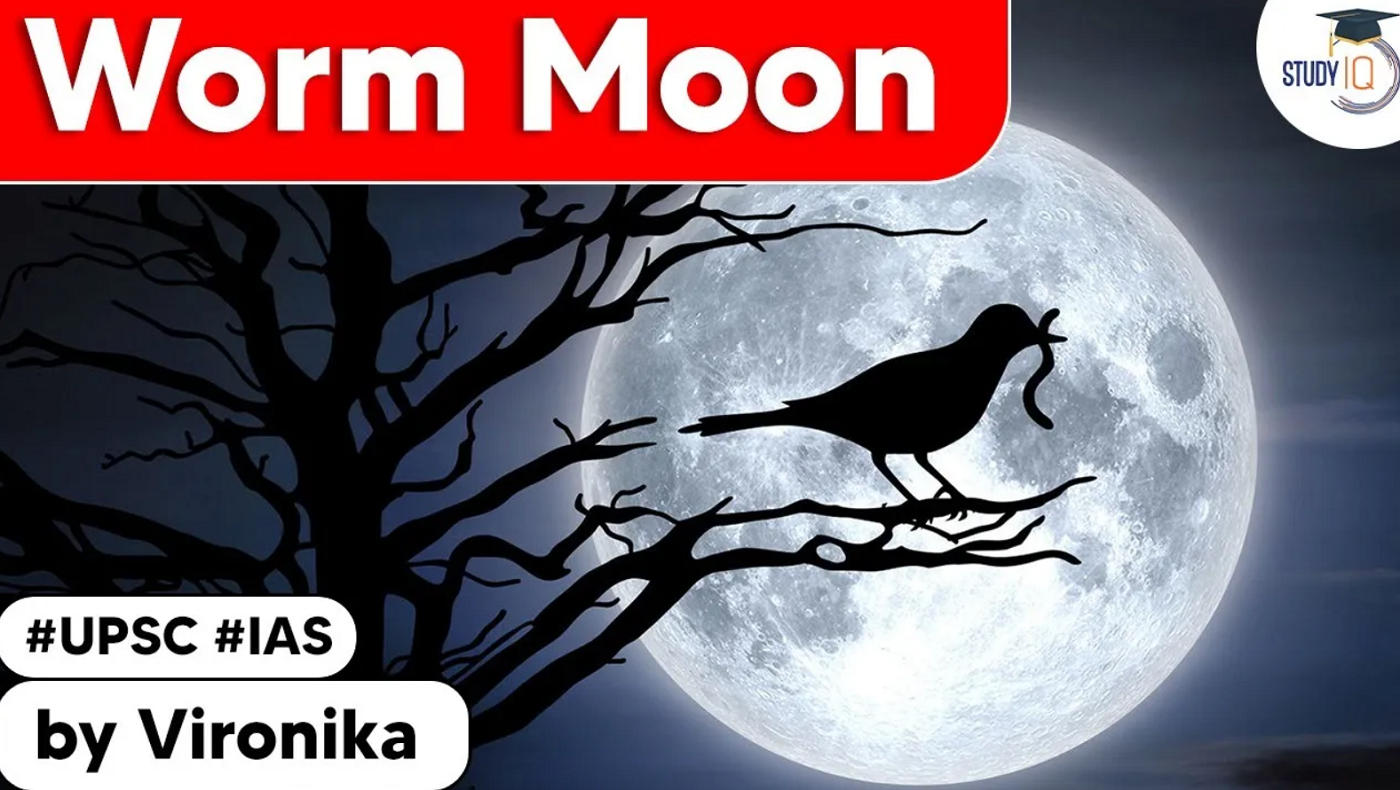Table of Contents
- Many parts of the world witnessed a brighter Moon last week, which also marked the beginning of the spring season.
- The Worm Moon – a rather unusual name – began shining brighter from Wednesday (March 16) evening and continued to spread its light till Saturday (March 19) morning.
- The peak occurred at 3.18am EDT on Friday (March 18 – 12.45pm IST), according to NASA. However, it was not visible in India because it’s usually brightest in the afternoon.
- This year’s Worm Moon is also a Supermoon and occurs two days before the Spring Equinox, also known as the Vernal Equinox, on March 20.
What is a Worm Moon?
- This is the last full Moon of the winter equinox and the beginning of spring. The name was given by some native American tribes.
- Two such events have already been reported this year – Wolf Moon on January 17 and Snow Moon on February 16.

- The full moon of January, called the Wolf Moon, occurred on Monday, Jan. 17, at 6:48 p.m. EST (1148 GMT), according to NASA.
- The January full moon is often called the Wolf Moon, according to the Old Farmer’s Almanac, which may date back to Native American tribes and early colonial times when wolves would howl outside villages.


- The full moon of February, called the Snow Moon, arrived on Wednesday (Feb. 16) at 11:57 a.m. EST (0457 GMT).
- That same day, Mercury reaches its greatest distance west of the sun, making it a bright but challenging to observe “morning star” in mid-northern latitudes.
- According to the Ontario Native Literacy Project, the Ojibwe (or Anishinaabe) peoples called the full moon of February Mikwa Giizis, the Bear Moon.
- The Cree called it the Kisipisim, or the Great Moon, because during this time of year “animals do not move around much, and trappers have little chance of catching them.”
Super moon
- The March Moon is being called a Supermoon as it appears much larger and brighter than a regular full moon. This happens because of the “Moon illusion”, according to CNN which quotes from the Farmer’s Almanac.
- The phenomenon occurs when the Moon is near the horizon and our eyes compare its size to trees, buildings or other objects.
Back to the Worm Moon
- There are many theories behind the origin of the term “Worm Moon”. One of them said the name referred to earthworms appearing as soil temperature increased at this time of year.
- However, later research claimed the name actually referred to beetle larvae emerging from thawing bark of trees.

- The March full moon is nicknamed the “worm moon” because of these slithery critters.
Other upcoming Full Moon
- Pink moon (April 16),
- flower moon (May 16),
- strawberry moon (June 14),
- buck moon (July 13),
- sturgeon moon (August 11),
- harvest moon (September 10),
- hunter’s moon (October 9),
- beaver moon (November 8) and
- cold moon (December 7).
What does term Equinox mean?
- Equinox comes from the Latin words equi, which means “equal” and nox, which means “night”. The astronomical event is caused by Earth’s tilt on its axis and its motion in orbit around the Sun.
- The phenomenon — the spring and fall equinoxes — happen twice in Earth’s year-long trip around the Sun.
- While on these days, the Sun shines almost equally on the Northern and Southern hemispheres, the rest of the year it shines unevenly over the two regions. That’s because Earth’s axis is tilted with respect to the Sun-Earth plane.
- Spring twilight at the North Pole begins a few weeks before the vernal, or spring equinox in March, when the Sun rises above the horizon again, NASA said.
What does lunar eclipse mean?
- A lunar eclipse occurs when the moon is completely or partially hidden in the Earth’s shadow. This phenomenon occurs during the full moon.
- Like the Earth, half of the Moon is illuminated by the sun at any one time. A full moon happens when the Moon and the Sun are on opposite sides of the Earth.
Why does the moon look red?
- When the moon is completely covered in the shadow of the earth, it becomes dark but not completely black. Instead, it looks red, so a full lunar eclipse is also called red or blood moon.
- Sunlight has all colors. While passing through the atmosphere of the Earth, the blue light is filtered while the red part passes through it. Therefore, the sky looks blue and redness prevails at sunrise and sunset.
- In the case of a lunar eclipse, the red light passes through the earth’s atmosphere and it turns towards the moon while the blue light remains out of it. This makes the moon look completely red.
Question:
Which of the following phenomena cannot be observed on the surface of the Moon?
- Rising and setting of the Sun
- Solar eclipse
- Motion of comets
- Twinkling of stars
Latest Burning Issues | Free PDF



























 WhatsApp
WhatsApp